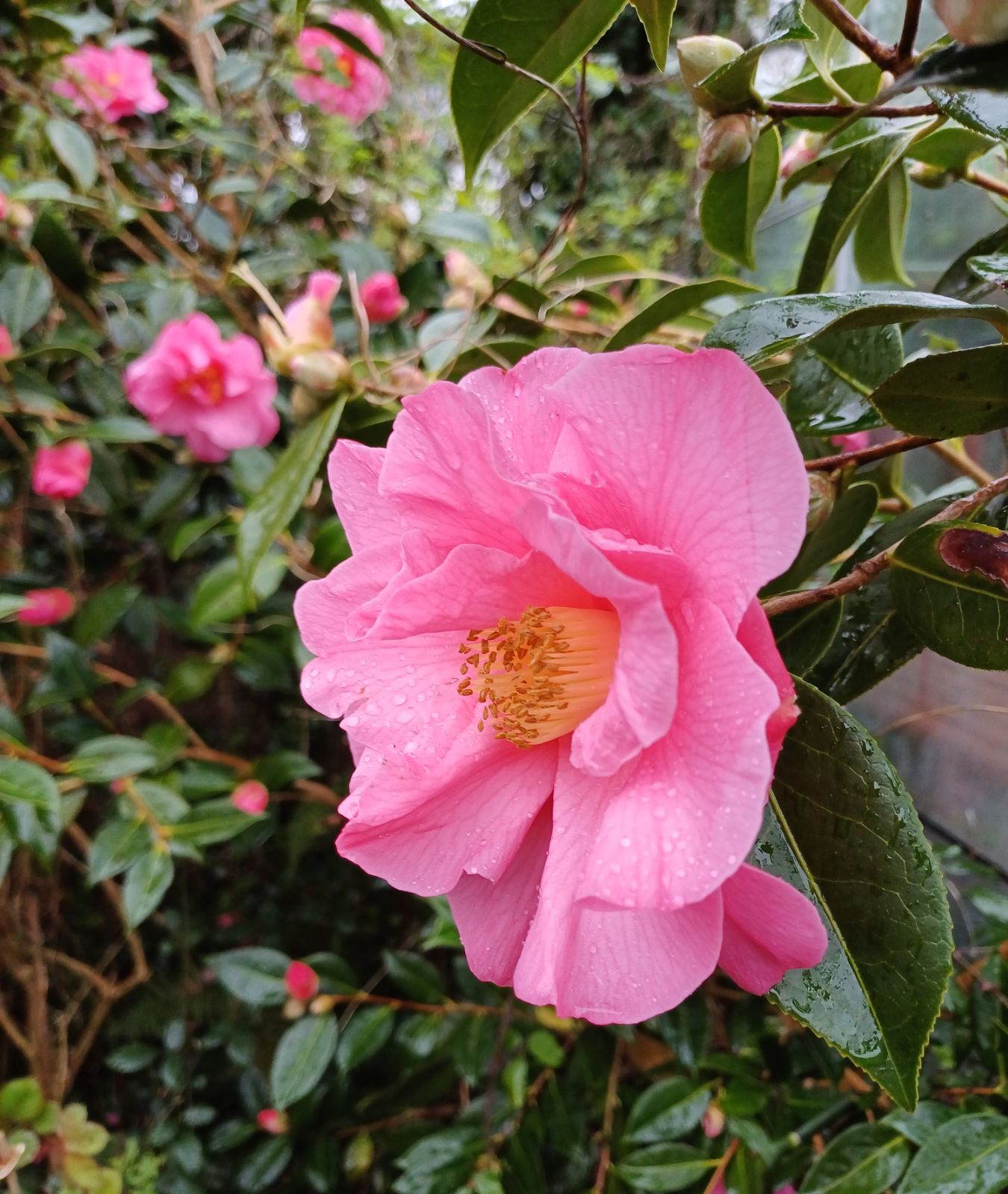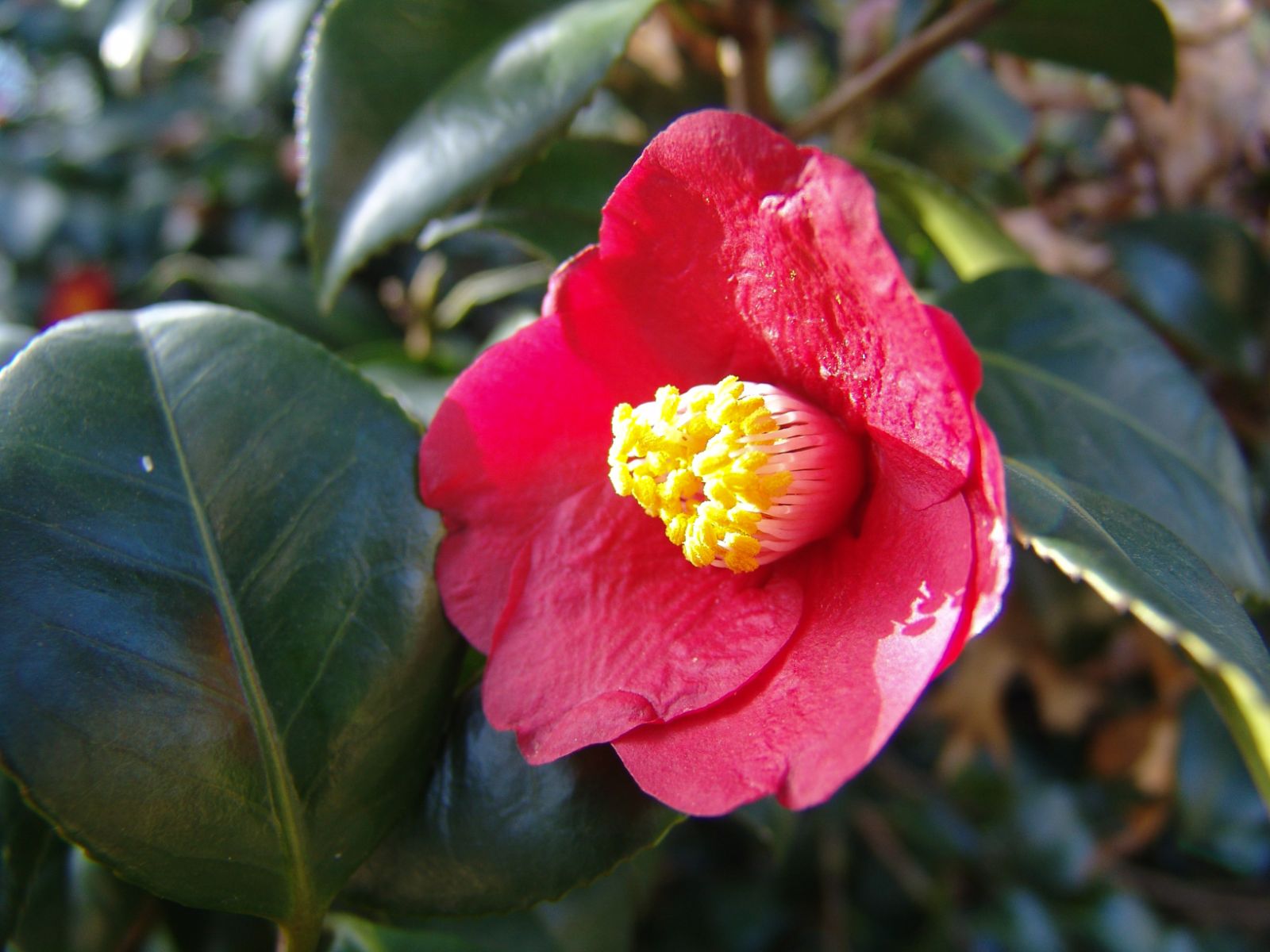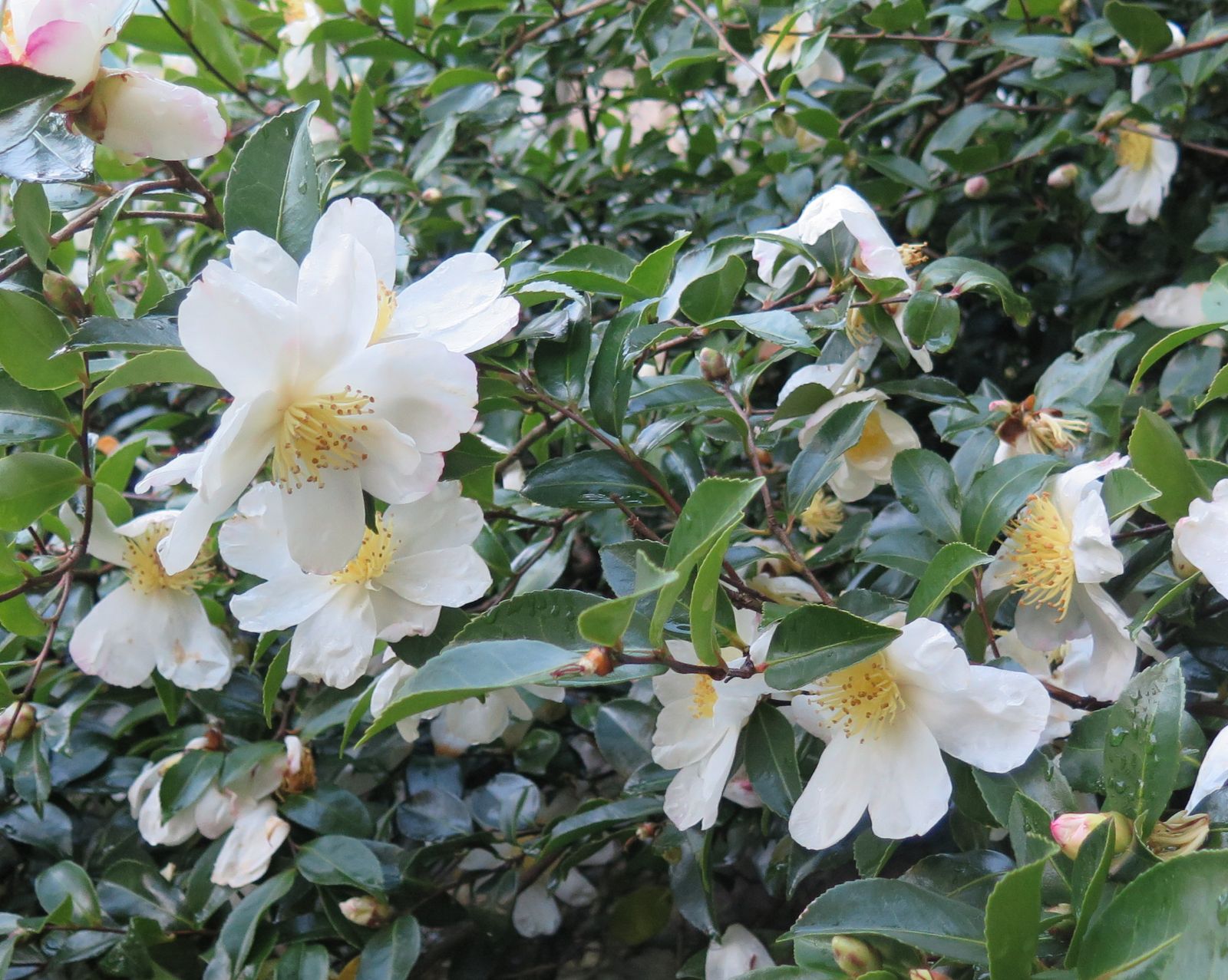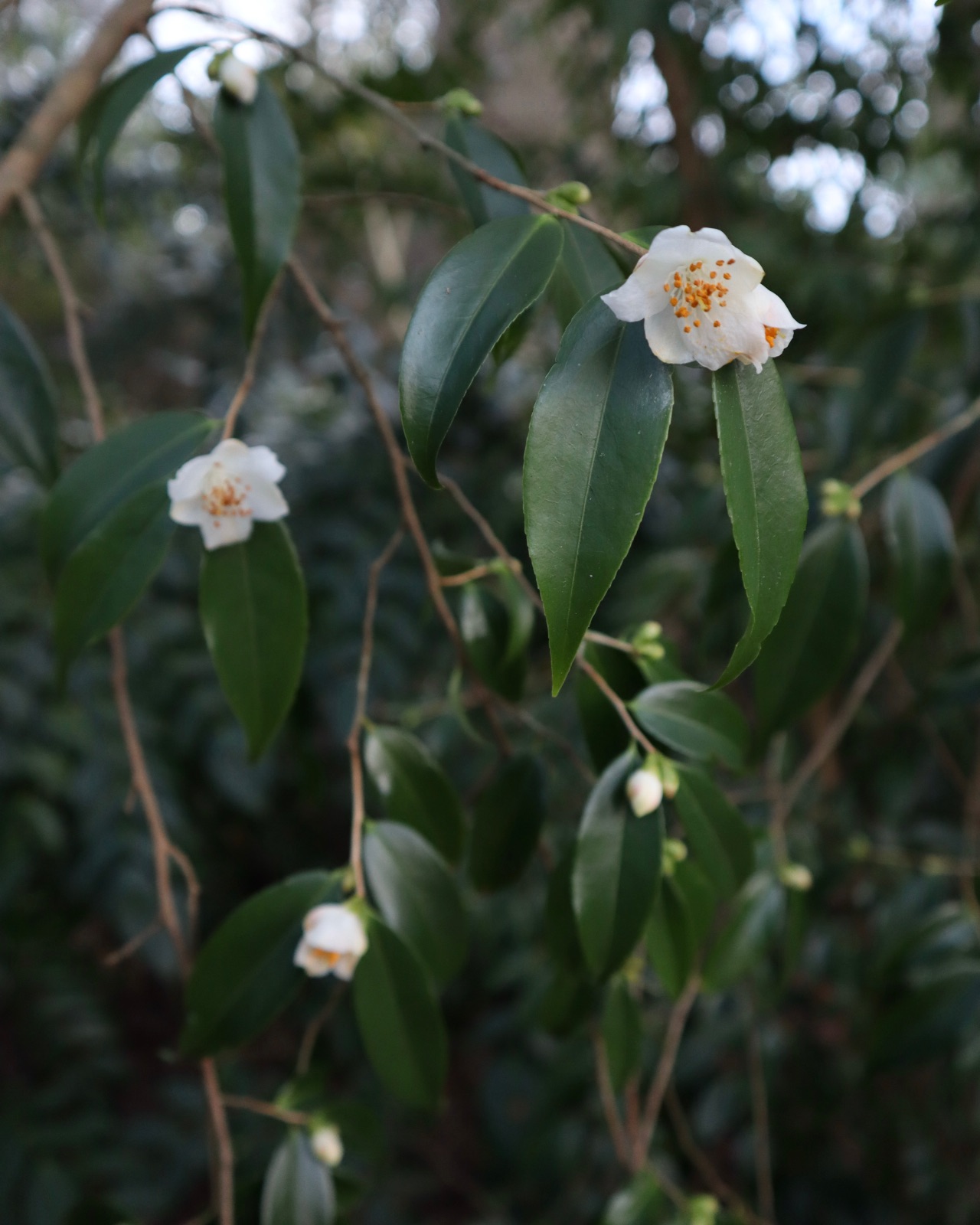Camellia
Credits
Article from Bean's Trees and Shrubs Hardy in the British Isles
Article from New Trees by John Grimshaw & Ross Bayton
Recommended citation
'Camellia' from the website Trees and Shrubs Online (treesandshrubsonline.
Family
- Theaceae
Common Names
- Camellias
Species in genus
- Camellia brevistyla
- Camellia caudata
- Camellia chekiangoleosa
- Camellia chrysantha
- Camellia costei
- Camellia crapnelliana
- Camellia cuspidata
- Camellia drupifera
- Camellia edithae
- Camellia forrestii
- Camellia furfuracea
- Camellia granthamiana
- Camellia japonica
- Camellia kissii
- Camellia lutchuensis
- Camellia maliflora
- Camellia oleifera
- Camellia ptilophylla
- Camellia reticulata
- Camellia saluenensis
- Camellia sasanqua
- Camellia sinensis
- Camellia taliensis
- Camellia tsaii
- Camellia × vernalis
- Camellia × williamsii
- Camellia yunnanensis
The most recent treatment of Camellia (Ming & Bartholomew 2007), on which this account is based, estimates that there are about 120 species in the genus. This estimate is conservative; Chang & Bartholomew (1984) recognised 200 species. Camellias occur from Nepal east to Japan and south to Indochina; in addition, Camellia lanceolata (Blume) Seem. occurs in Indonesia and the Philippines. They are evergreen trees or shrubs, grown primarily for their large, hermaphrodite flowers. The leaves are leathery with serrate or rarely entire margins; they are usually petiolate though they can be sessile or amplexicaul. The flowers are axillary or subterminal, and solitary or in clusters of up to three. Flowers may be pedicellate with 2–10 distinct bracteoles and five (to six) distinct sepals (subgenus Thea), or subsessile with around 10 undifferentiated bracteoles/sepals (subgenus Camellia). The petals, 5–8(–12), are white, pink, red or yellow; the stamens numerous, in two to six whorls, the outer whorl fused to the petals. The fruit is a globose or subglobose capsule, which splits from the apex via three to five valves; central column present or absent (Sealy 1958, Chang & Bartholomew 1984, Ming & Bartholomew 2007).
Camellia has an enthusiastic following, including the members of the International Camellia Society, and numerous well-illustrated reference works are available (Sealy 1958, Chang 1981, Chang & Bartholomew 1984, Trehane 1990, Ming 2000, Gao et al. 2005, Trehane 2007). The present account describes only recently introduced species whose natural habit is to form a tree of more than 5 m tall, and which are cultivated in our core area. The following ‘new’ shrubby species (normally below 5 m tall) are also in cultivation in our area: C. amplexifolia Merr. & Chun, C. fluviatilis Hand.-Mazz., C. fraterna Hance, C. grijsii Hance, C. transarisanensis Hayata, C. tricho clada (Rehder) S.S. Chien, C. wardii Kobuski and C. xylocarpa (Hu) Hung T. Chang. In addition, the following are known to be in cultivation in southern California, and could conceivably be found in collections in our area where climatic conditions permit: C. chrysanthoides Hung T. Chang, C. crassicolumna Hung T. Chang, C. euryoides Lindl., C. flavida Hung T. Chang, C. gaudichaudii (Gagnep.) Sealy, C. impressinervis Hung T. Chang & S. Ye Liang, C. indo chinensis Merr., C. mairei Melch., C. petelotii (Merr.) Sealy, C. salicifolia Champ., C. semiserrata C.W. Chi and C. synaptica Sealy. One of the most exciting discoveries and introductions in recent years has been C. cucphuongensis Tran Ninh & J.-C. Rosmann, from lowland Vietnam. Although it is almost certainly not hardy in our area, its gorgeous golden flowers make this a highly desirable plant for the conservatory. In addition to the nominate species described below, many infraspecific taxa exist, for details of which see other references, especially Ming & Bartholomew (2007). All species mentioned or described here are illustrated in Collected Species of the Genus Camellia: An Illustrated Outline (Gao et al. 2005).
The establishment of England’s first commercial tea plantation (albeit on a small scale) at Tregothnan, Cornwall from 1999 onwards is an indication of the currently increasingly warm climate, and of the willingness of good gardeners to experiment and take risks. Camellia sinensis was described by Bean (1976a) but he did not predict that it could come to be grown outside in the British Isles, and it may be that some of the species listed above may also become growable in our area. Another development leading to the more widespread cultivation of camellias has been the intensive work carried out in the United States, in search of ever-increasing hardiness in ‘standard’ camellias. The interest in this of the Parks family of Camellia Forest Nursery, Chapel Hill, North Carolina started when a devastating freeze down to –23ºC in 1985 killed almost all of Clifford Parks’s large collection. The survivors, which included C. oleifera and a handful of C. japonica cultivars and other hybrids, have since been used to breed and select new hardy cultivars, some of which are now considered hardy to Zone 6b. Among these are the C. sasanqua C. oleifera hybrid ‘Survivor’ which withstood the 1985 frost and is now cultivated in Ontario, and ‘Mason Farm’ of the same parentage. Dr William Ackermann of the US National Arboretum has also used this combination of parents to create a number of very cold-tolerant cultivars, including the bright pink ‘Winter’s Joy’ (Ackermann 2007). Most of these start flowering in autumn and continue through the winter. The same breeders have also worked with C. japonica survivors to develop selections hardy to Zone 6b at least, including the April Series from Camellia Forest Nursery (Ward 2004).
Although often thought of as a ‘shrubby’ genus on account of their dense growth and (in northern Europe at least) often low stature, many species of Camellia are naturally single-stemmed trees capable of reaching impressive size. These include the familiar C. japonica and C. reticulata, from which so many of the well-known garden camellias have been derived. The species described below are as yet mostly unknown to all but a few Camellia enthusiasts, principally in the United States, and only a handful are currently available in Europe. Unfortunately none have been observed in the course of research for New Trees, so notes are derived entirely from secondary sources. In almost all cases a warm sheltered site will be necessary, with attention to the usual Camellia preferences for acidic soil and ample moisture. In cultivation, propagation will usually be by cuttings.
Bean’s Trees and Shrubs
Camellia
A group of about eighty species of evergreen trees and shrubs widely distributed in Asia. Leaves alternate, toothed, short-stalked. Flowers usually showy, often solitary or two, never more than a few together, either clearly stalked with two to five bracteoles distinct from the five persistent sepals or appearing sessile because the short pedicel is completely covered by a series of overlapping, usually deciduous bud-scales which represent bracteoles and sepals; petals five to twelve, usually firmly united to the androecium and falling with it, but sometimes free; stamens numerous, the outer united for at least a short distance at the base and usually much higher to form a distinct fleshy tube. Seeds large and oily, soon decaying.
The genus was named by Linnaeus after George Joseph Kamel, a native of Moravia and a member of the Society of Jesus. He latinised his name into Camellus and under it wrote an account of the plants of the Island of Luzon in the Philippines, which he had visited. This account John Ray included as an appendix to his Historia Plantarum, published in London in 1704.
Until the introduction of C. saluenensis, hybrids were unknown, but once that species became established hybrids were raised between it and C. japonica and C. cuspidata, and the success of these crosses has led to a surfeit of crossing with each and every species and hybrid in cultivation. A comprehensive list of hybrids is given in the American Camellia Year Book, 1966, pp. 113–42, and see also pp. 203–27. Camellia has become a favoured genus, especially in the United States and Australia, and in addition to various regional and national Camellia societies, which publish journals – the largest being The American Camellia Society – there is now an International Camellia Society which publishes a journal, while the Royal Horticultural Society produces annually a Rhododendron and Camellia Year Book. The standard work on the species is: J. R. Sealy, A Revision of the Genus Camellia, London, 1958, illustrated with numerous line-drawings.
All the camellias prefer a peaty soil, but will thrive in a warm, open loam, especially if leaf-soil and a little peat be given them to start with, and so long as the soil is lime-free. They can be increased by stem and leaf-bud cuttings of half-ripened wood inserted in a mixture of sand and peat in a propagating frame. Bottom heat is desirable but not essential. C. reticulata is an exception and should be grafted onto seedlings of C. japonica of suitable size.
From the Supplement (Vol.V)
In his A Revision of the Genus Camellia (1958), J. R. Sealy treated and classified eighty-two species and in a concluding chapter discussed a few others which for one reason or another were imperfectly known. Since the publication of that pioneering work, the number of named species in the genus has almost doubled, most of the newcomers having been described by Professor Chang in a monograph published in Chinese in 1981 and now available, with additions and amendments, in an English translation: Chang Hung Ta and Bruce Bartholomew, Camellias (1984). This work recognises some 200 species, grouped in a revised classification, with keys and numerous line-drawings. Most of the new species are described from recent collections in central and southern China, and while some are obviously distinct, many are closely related to those treated in Sealy’s Revision. The two works are not strictly comparable, since Professor Chang does not deal in detail with any of the horticulturally important species, as indeed Dr Bartholomew points out in his valuable preface.
Recent Literature
Durrant, T. – The Camellia Story. Auckland, 1981. A very well illustrated general account by a New Zealand authority.
Feathers, D. L., and Brown, M. H. (eds). – The Camellia; its history, culture, genetics… . American Camellia Society, 1978.
Longhurst, P., and Savige, T. J. – The Camellia. Sydney, 1982. Fifty-three colour plates from paintings by Peter Longhurst.
Macoboy, Stirling – The Colour Dictionary of Camellias. Sydney, 1981. A fully illustrated and well researched book by an Australian horticulturist, with contributions by experts on the various groups.
Trehane, David – Camellias. London, 1985. A short guide to choice and cultivation, published in the new series of Wisley Handbooks.
- – Trehane Camellias. n.d. A commercial catalogue with colour illustrations and useful descriptions.
Treseder, N., and Hyams, E. – Growing Camellias. London, 1975.
Tuyama, Takasi (ed.) – Camellias of Japan. Osaka, 1968. Vol. 1, descriptions of cultivars in English; Vol. 2, colour plates.
The Rhododendron and Camellia Year Book of the Royal Horticultural Society ceased publication after 1971. But camellias still feature in its successor – Rhododendrons [year] with Camellias and Magnolias, published annually.
Doubleness in the flowers of camellia cultivars is the result of the conversion of individual stamens, or clusters of stamens, into additional petals or into petalodes (petaloids), which are of intermediate form. In Semi-double flowers there are extra rows of petals but a central boss of stamens is still present, as in C. × williamsii ‘Donation’ or C. japonica ‘Mars’. In Anemone-centred flowers the central boss is replaced by a cluster of petalodes, with or without stamens, clearly differentiated from the spreading petals, as in C. japonica ‘Elegans’.
In Paeony-form flowers (informal doubles) there is less or no differentiation between the outer whorls of petals, which are irregular in form and tend to the upright position, and the central mass of stamens and petalodes. Most cultivars of this type have flowers of what is termed ‘loose paeony form’, in which the parts are rather laxly arranged, in contrast to the ‘full paeony form’ flowers which tend to a firmer, convex shape and may lack visible stamens. But the difference between these categories is not very clear cut.
In Formal Double flowers as a rule no stamens are visible and the numerous petals are imbricated (or sometimes arranged in radial rows); but the central petals often tend to form a bud-like cluster, which may conceal stamens, or in the so-called Rose-Form Double flowers, eventually open to reveal the stamens.
Before the breeding behaviour of the species of Camellia had been studied in depth, some stated hybrid parentages were pronounced impossible on chromosomal grounds. But scientific research has shown that these doubts were unfounded. In this connection the investigations of William L. Ackerman are of great interest. He has shown, for example, that, contrary to what was once stated, the diploid C. saluenensis can be crossed with the hexaploid (sometimes triploid) C. reticulata, the offspring being mostly tetraploid (Genetic and Cytological Studies with Camellia and Related Genera, USDA Technical Bulletin 1427 (1971)).





